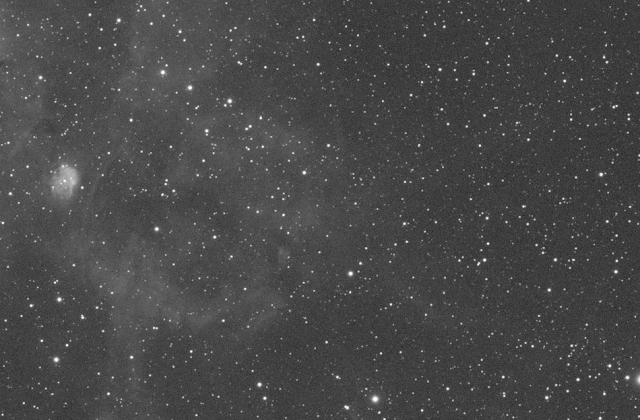- Preprocess Script with default values
- Preprocess Script for calibrating and registering and ImageIntegration with Sigma High and Low parameter optimization
- Custom Weights (using the Subframe selector script) plus everything in #2
- Everything in #3 plus DrizzleIntegration
I then used the SubframeSelector script in Pixinsight to measure these images:
| FWHM (pixel) | SNRWeight | |
| #1 |
1.766
|
3.427
|
#2
|
1.770
|
3.692
|
#3
|
1.754
|
3.710
|
#4
|
3.693
|
6.927
|
The FWHM increase in #4 is surprising. But remember that drizzling upsamples the entire image by 2. So, for a better comparison, I downsampled #4 by 2:
| FWHM (pixel) | SNRWeight | |
| #4 - downsampled |
2.016
|
7.249
|
The degradation in FHWM is unfortunate - but the increase in SNR is amazing!!!
---
Vicent recommended to try Gaussian drops for DrizzleIntegration. He saw in my sample images a significant drop in FWHM. With that, I get:
| FWHM (pixel) | SNRWeight | |
| #4 - downsampled Gaussian drop |
1.953
|
5.674
|
First observation was: Drizzling with Gaussian samples is MUCH slower (several times slower then with square drops).
So, FWHM is significantly down. But so is the SNR. Vicent recommended to set the "Drop Shrink" parameter to 1 if I use Gaussian drops. With that, I get:
I.e. no improvement in SNR but a slight degredation in FWHM. My main challenge when imaging from our backyard is the noise from the light pollution. So, I think I stick with square drops.
So, FWHM is significantly down. But so is the SNR. Vicent recommended to set the "Drop Shrink" parameter to 1 if I use Gaussian drops. With that, I get:
| FWHM (pixel) | SNRWeight | |
| #4 - downsampled Gaussian drop - Drop Shrink=1 |
1.963
|
5.674
|
I.e. no improvement in SNR but a slight degredation in FWHM. My main challenge when imaging from our backyard is the noise from the light pollution. So, I think I stick with square drops.
This is also visible in the (stretched) images:
 |
| DrizzleIntegration with Square drops |
 |
| DrizzleIntegration with Gaussian drops |
There is much more detail when using Square drops. So, I'll go with that one (for now).
No comments:
Post a Comment